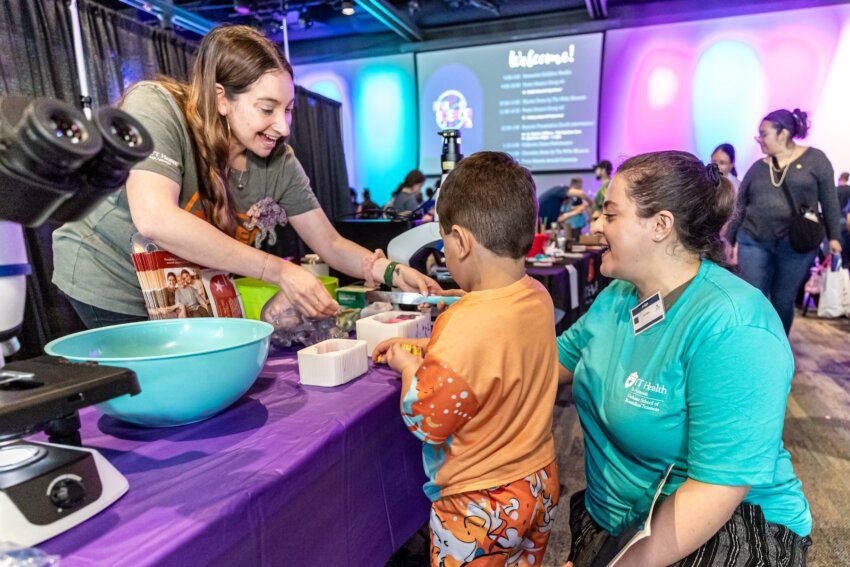Keynote speaker discusses stroke trial and health literacy
More than 1,500 community members attended the 2024 Viva Science SA event Saturday, April 20, at the Witte Museum. The free, family-friendly event drew people of all ages who enjoyed a day of scientific education and fun by gazing into microscopes, learning about different science disciplines and partaking in interactive and hands-on science experiments. Kids also had an opportunity to visit a petting zoo and play fun games.
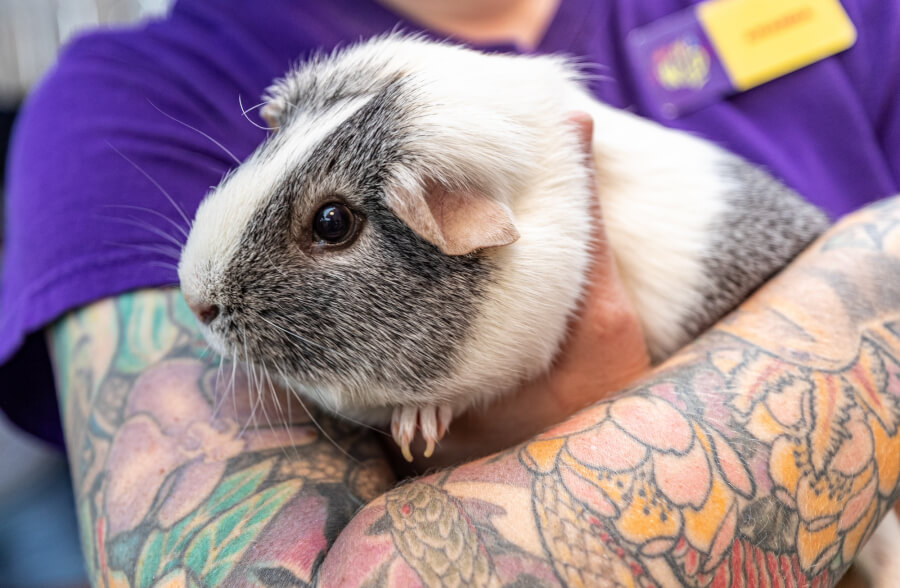
With 45 booths representing a wide array of local institutions and 87 research posters representing middle schools, high schools, undergraduates and professionals, attendees’ eyes lit up with wonder as they visited science-themed tables featuring kid-friendly chemistry experiments, a robotics demonstration, 3-D printed brain molds, slides of microbes, fungi and bacteria and much more.
At the table representing the Brain Bank at the Glenn Biggs Institute for Alzheimer’s and Neurodegenerative Diseases, visitors could view slides of neurons and tissue and look at a model of the brain.
As Harvey Jaafar looked through a microscope at the Brain Bank table, he was filled with wonder. His mother, Afaf Saliba Jaafar, a UT Health San Antonio Integrated Biomedical Sciences program graduate student who will receive her PhD in May, was happy to bring her children to the event that showcased the importance of science.
“It’s important that kids start learning science at a very young age and understand that it’s for a good purpose,” Jaafar said. “Science is fun. It enhances intellectual capabilities and widens opportunities for future careers, growth and for exploring the world, making it a better place.”
Visitors at the UT Health San Antonio Medical Laboratory Sciences table had the opportunity to look through microscopes and learn about bacteria and fungi.
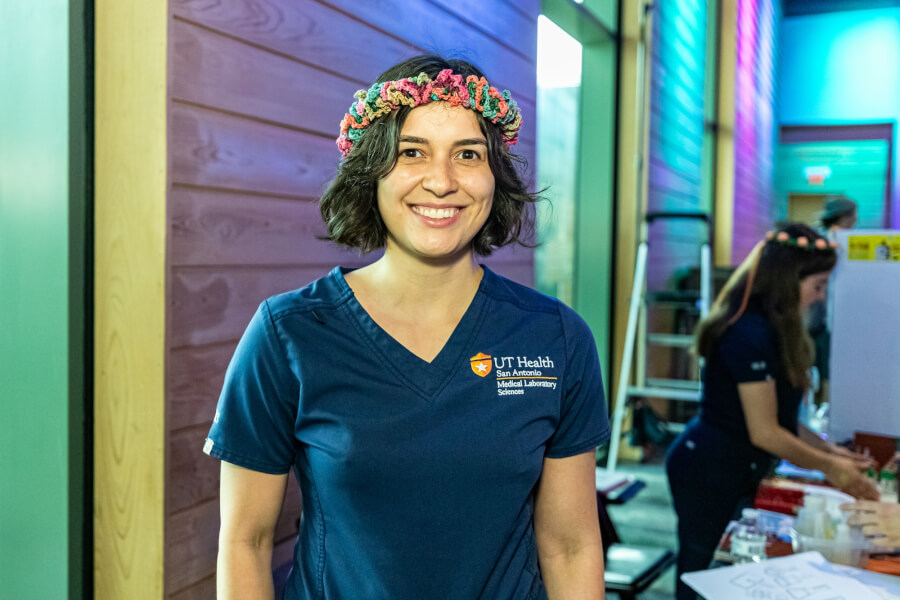
“I believe this is a very important thing, for children to start learning from a very young age about the medical relevance of laboratory sciences,” said first-year UT Health San Antonio Medical Sciences Laboratory student Alessandra Vaccaro. “Many children are familiar with doctors, PAs, nurses and other health care professionals. However, most children, and even adults, don’t realize how essential medical lab scientists are in diagnosing relevant conditions like cancer, heart disease, COPD, and diabetes, to name a few. Although we operate behind the scenes and away from the crowd, we remain a paramount piece of a larger and more complex health care puzzle, committed to championing unparalleled patient care alongside our health care professional peers.”
“Many organisms such as bacteria, fungi and viruses are ubiquitous in the environment,” Vaccaro said. “They are on our skin, on objects children play with, and even in the air we breathe. It is important for us to serve as a scaffold to children and teach them about the wonders of the microscopic world. We lab scientists are also here to help children distinguish between innocuous organisms and those that may cause harm, and how the power of diagnostics can help in finding the right treatments.”
Created several years ago by students from the Graduate School of Biomedical Sciences at UT Health San Antonio, Viva Science SA is part of the graduate school’s initiative to make science accessible for everyone. The event showcased the importance of science, technology, engineering and mathematics (STEM) programs and supported discussions of science-related efforts and research.
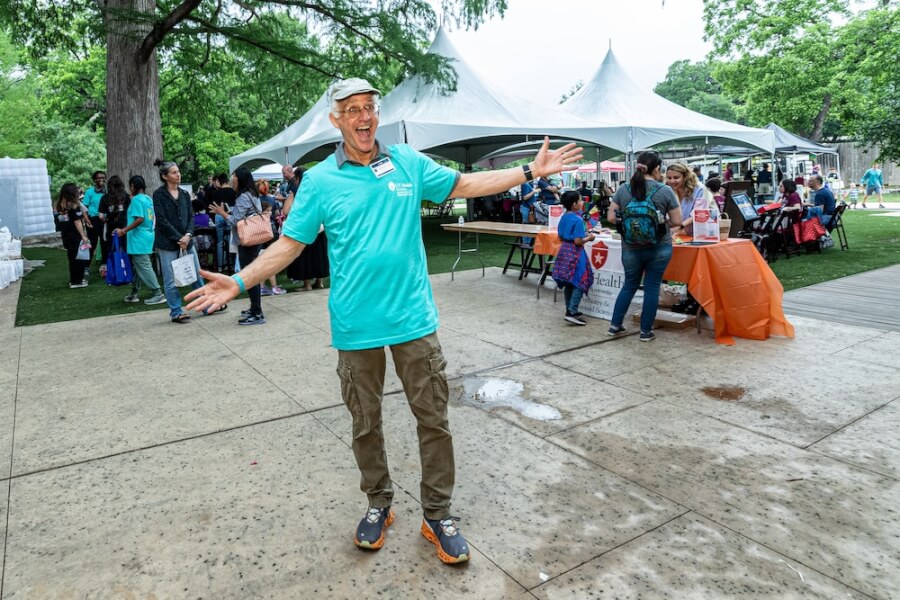
David Weiss, PhD, dean of the Graduate School of Biomedical Sciences (GSBS), said the event’s creators wanted scientists throughout the city to be able to talk about their science to the public.
“The key is to learn how to communicate your science,” he said. “It’s not just our students, they’re from other schools all the way down to middle school,” he said. “This events helps to teach them how to communicate with somebody at any level.”
Weiss added that the event was also created to highlight the many scientific endeavors taking place throughout the city.
“San Antonio is becoming a powerhouse in the country in science, so it’s a great way to showcase that,” he said.
The event was a learning experience for both students and visitors alike. Students honed their presentation skills while discussing research posters and conveying science-related topics at dozens of tables and attendees asked questions and learned about the many scientific endeavors throughout the city.
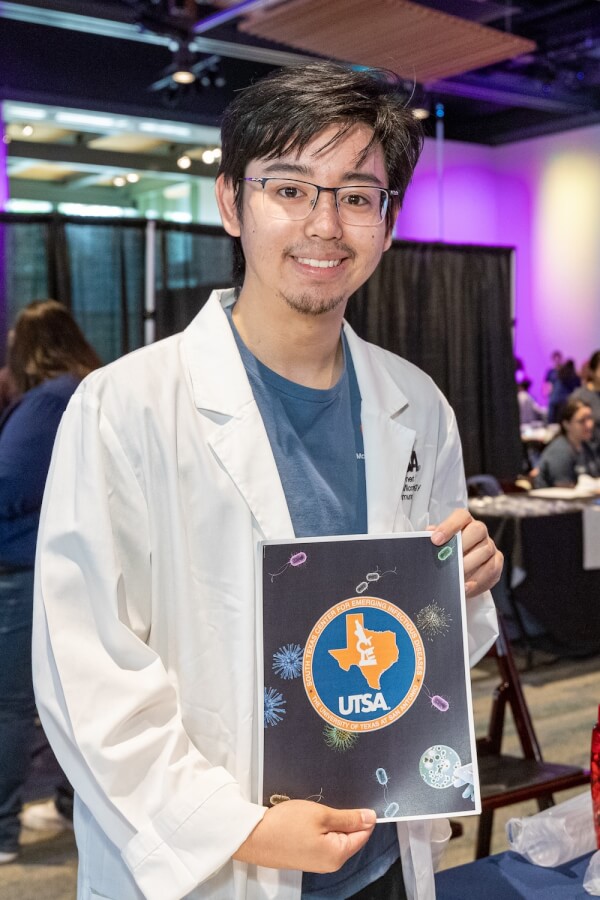
Kendall Esparrago, a graduate student in the molecular microbiology and immunology department at The University of Texas at San Antonio, expertly presented information about the South Texas Center for Emerging Infectious Diseases and provided visitors an opportunity to learn about microbes and how they affect our lives.
When he was younger, the graduate student didn’t have science-themed events to attend, so providing an opportunity like Viva Science for kids to learn about science early is beneficial, he said.
“Getting [kids] really invested early on is really important, especially since we’re in the computer age where these kids can now investigate on their own,” he said. “So, if you keep their interest, they can go back later to their [home] and look up what microbes are and become a researcher themselves.”
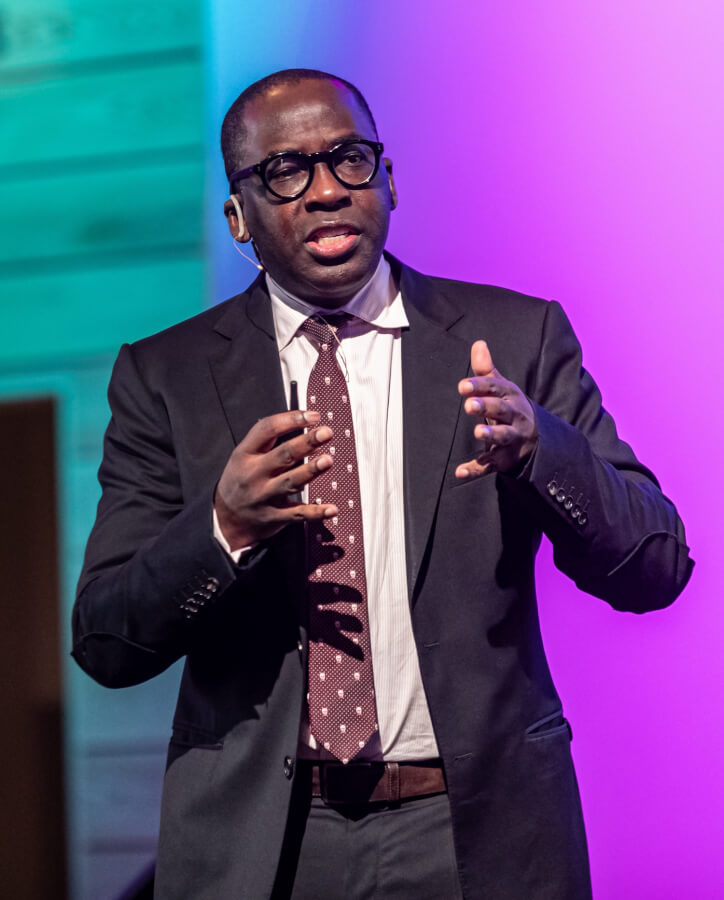
How getting kids involved in science can help save lives
The event’s keynote speaker, Olajide A. Williams, MD, MS, professor of neurology and vice dean of community health at the Columbia University Vagelos College of Physicians and Surgeons, spoke about a National Institutes of Health-funded stroke trial evaluating the efficacy of Hip Hop Stroke: a hip-hop based stroke literacy intervention targeting elementary school children. Williams detailed how the trial came about and his career path.
Williams began his career at the bedside of patients at a hospital in Harlem, New York, where only 1.9% of patients were being treated for strokes. The reason for the low treatment numbers was that too many patients were arriving beyond the treatment window. Back then, the window was three hours. Today, it’s 4.5 hours.
It was found that a lot of patients treated for stroke were in their late 30s, 40s and early 50s.
Williams wanted to know why such a low number of patients sought treatment for stroke during that crucial time window. Through research, he learned that it was due to lack of knowledge. Individuals suffering from stroke either didn’t recognize the symptoms or didn’t know that treatment was available within a very short time window and thought they could call the doctor to make an appointment to address it at a later time.
To address low health literacy about strokes, Williams and his team focused on raising awareness about stroke symptoms and the importance of getting to the hospital in that three-hour window. The question was how to convey that important information to an audience that was busy working and raising their children. The answer came from Williams’ own experience helping his children with their homework. He realized that every time he helped them, he was learning.
“[My team and I] hypothesized that making children health literate for a particular condition can, in turn, make their parents and their caregivers health literate through our homework protocol,” he said.
As a neurologist studying the brain since 1998, Williams knew that there is twice as much real estate in the brain dedicated to music as opposed to language. With that in mind, and with support from the National Stroke Association, an intervention model was developed combining art, culture and science.
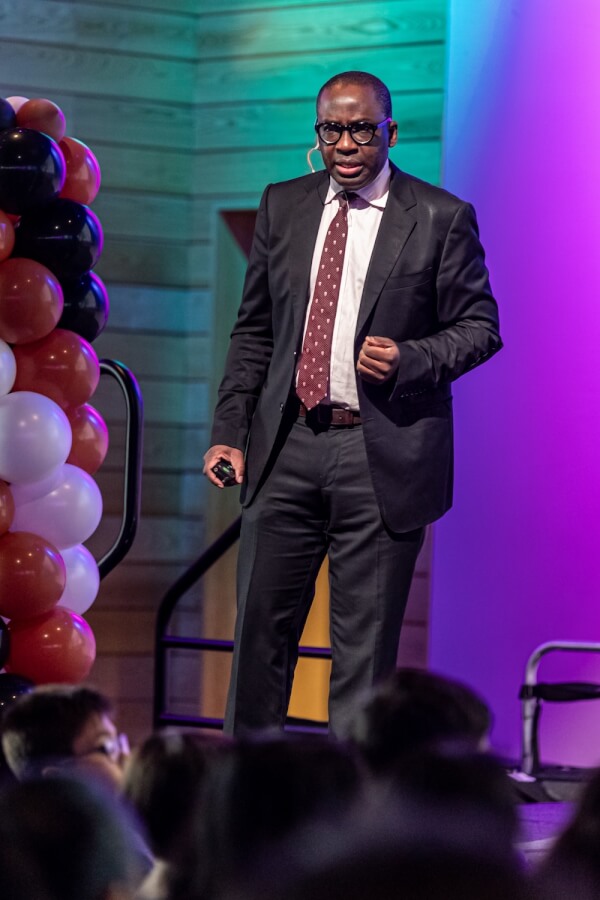
“Music is a superpower,” Williams said. “Music helps us learn, it helps us retain, remember. It calms us, it reduces our stress. Music, we believed, had the ability, if done right, to increase health literacy in a way that those children could transfer to their parents and their grandparents, for the specific purpose of recognizing the symptoms of stroke and the importance of calling 911 within those 3 hours. That was our goal and music was our vehicle.”
Williams partnered with music artist Doug. E. Fresh to develop Hip Hop Stroke, which ultimately led to the creation of Hip Hop Public Health, an internationally recognized organization that creates and implements multimedia public health interventions that target and engage young people in the health of their families and communities.
The next step was for Williams, Fresh and other scientists on their team to recruit the brightest fifth-grade students in Harlem to serve on a student advisory board to provide insight about what would engage their peers and raise stroke awareness.
With insights from all involved on their team, homework protocols for the children in the stroke trial were created. The kids’ homework included watching videos, doing crosswords and learning acronyms with their parents. The study found that the kids were very engaged and excited about transferring their knowledge about strokes and their parents also did extremely well.
As a result of the intervention, the treatment rates for stroke at the hospital quadrupled, increasing from 1.9% to 8%.
Near the end of his talk, Williams showed engaging educational videos he and his team created to increase knowledge about strokes. View this Hip Hop Public Health video featuring the important acronym BE FAST for recognizing and acting when stroke occurs. The acronym stands for:
- Balance: feeling off and dizzy.
- Eyes: trouble with seeing.
- Face: numbness and weakness in the face and drooping in the cheek.
- Arm: numb or not being able to use an arm or leg.
- Speech: trouble speaking.
- Time: Call 911 immediately.
Williams concluded with a video featuring a father whose life was saved when his fifth-grade son remembered what he learned through Hip Hop Public Health’s stroke awareness intervention.
The child said he remembered learning that it’s important to call 911 when seeing someone with blurry vision, weak arms and experiencing a bad headache. The child’s mother said that knowledge gave her husband a second chance in life.
To learn more about the signs and symptoms of a stroke, visit the Centers for Disease Control and Prevention website.
Why events like Viva Science are important
Williams said scientifically oriented events like Viva Science are critical.
“I think every city in America should have an event like this,” he said. “I think really improving scientific literacy in children really does inspire and spark their imagination. And we know that imagination is key to innovation. And in a world where there are so many challenges, building a cohort of exceptionally innovative and scientifically grounded children, can only be better for our collective future.”


